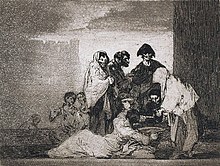Lathyrism
| Classification according to ICD-10 | |
|---|---|
| T62 | Toxic effect of other harmful substances ingested with food |
| T62.2 | Other consumed plant (s) or part (s) thereof |
| ICD-10 online (WHO version 2019) | |
In Lathyrism is a chronic neurological disease of toxic origin. Lathyrism is permanent consumption of flour of drought tolerant Lathyrus sativus ( Lathyrus sativus caused), and is an example of the effect of a natural excitotoxin which selectively to the first motor neuron acts.
etiology
The toxin is effective β-N-oxalylamino-L-alanine (BOAA), which selectively on the AMPA glutamate - receptor acts. Chronic ingestion of the toxin results in increased intracellular free radical concentrations and decreased function of mitochondrial oxidative phosphorylation . Pathologically , the giant Betz cells of the primarily motor cortex , which innervate the muscles of the lower extremities, are primarily affected.
Symptoms

Clinically, lathyric neurotoxicity manifests itself in muscle spasms, cramps of the limb muscles and progressive spastic paralysis ( paresis ) of the leg muscles. The walk in which the affected person actually falls from one leg to the other is typical. Sensory and bladder dysfunction can also occur. Occasionally, gross tremor of the arms is observed.
Occurrence
Lathyrism occurs epidemically in drought areas when the flour of the flat pea becomes the main food. Epidemics have been described in Bangladesh, China, Ethiopia and India. There were historical outbreaks in Spain, for example, at the time of the Napoleonic Wars , when the starving population lived mainly on flat peas ( Almorta ).
swell
- Murray and Mitsumoto: Disorders of upper and lower motoneurons. Neurology in clinical practice, Vol 2., Bradley et al. (eds), Elsevier 2004